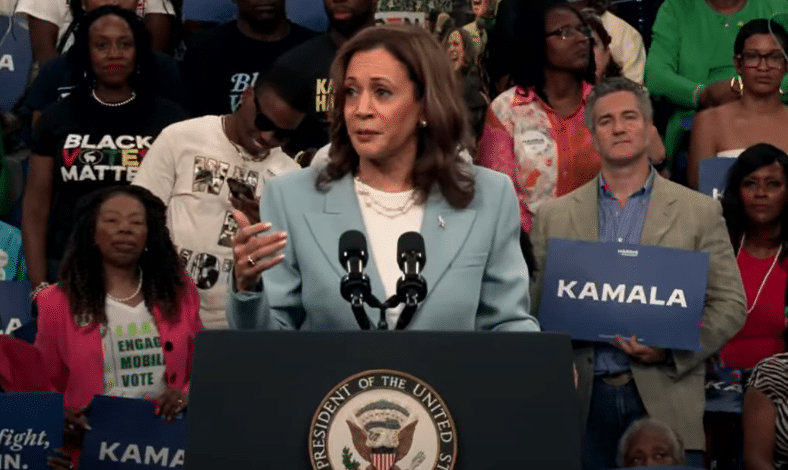
Vice President Kamala Harris has caught up to former President Donald Trump in the latest national polling average compiled by RealClearPolling.com, 47 percent to 46.8 percent.
This comes after Trump had been leading the average against President Joe Biden since Sept. 2023, but Democrats dumped Biden, nominated Harris, and appear to have reconsolidated the Democratic base, giving Harris an edge in the national polling.
The implication is that the national popular vote—which is what national polls measure—is up for grabs. Republicans have not won the popular vote in a presidential election since 2004, when George W. Bush was reelected.
But Republicans don’t need the popular vote per se in order to prevail in the Electoral College. Notable examples include Bush’s win over Al Gore in 2000 and Trump’s win over Hillary Clinton in 2016, where the Republican candidate lost the popular vote but still won the election.
Other examples have included the 1824 election of John Quincy Adams over Andrew Jackson, when no candidate received a majority of the Electoral College and so the election went to the House of Representatives.
Similarly, in 1876, Republican Rutherford Hayes lost the popular vote but won the Electoral College over Democrat Samuel Tilden.
And in 1888, Benjamin Harrison defeated Grover Cleveland in the Electoral College despite losing the popular vote.
In all five instances, the losing candidate was a Democrat, whereas no Republican has ever won the popular vote and lost the Electoral College. So, this is not unfamiliar territory for Republicans historically, and certainly not Trump, who was still able to win in 2016 without the national popular vote.
2020 is another example where it almost happened again. In the 2020 cycle, 293 polls were taken, Biden led 285 of them, or 97 percent and won the popular vote easily 51.3 percent to 46.8 percent. But only a scant 43,000 separate Biden and Trump in three swing states: Wisconsin (23,000), Georgia (10,000) and Arizona (10,000).
And in 2016, Hillary Clinton led 219 out of 259 polls taken, or 85 percent of them. And it correctly predicted she would win the popular vote, 48.2 percent to 46.1 percent.
But in both cases, Trump overperformed what the polling averages had shown. For example, in 2020, the polling average had Trump at 44 percent but he came in at 46.8 percent. And in 2016, Trump’s average was 43.2 percent but he came in at 46.1 percent. That’s an average 2.8 percent that Trump has underpolled the past two elections. To be fair, in 2016, Hillary Clinton underpolled, too, showing 46.8 percent but coming in at 48.2 percent, a 1.4 percent spread.
So, if the polls show the national popular vote tied, that might mean Trump still has an edge, simply because of the “shy” Trump voter that we don’t see in the polls but who shows up on Election Day all the same.
In modern history, Republicans’ popular vote deficit is easily explained by demographics. Blacks and Hispanics who tend to vote Democratic 5 to 1 and 2 to 1, respectively, have higher birth rates than Whites who tend to vote Republican 3 to 2, according to the 2020 CNN Exit Poll.
Nationally, more non-Hispanic Whites die every year than are born. In 2022, 2.44 million Whites died whereas only 1.84 million were born. Whereas, the same year, almost 412,000 Blacks died and more than 511,000 were born, and 275,000 Hispanics died and 937,000 were born, according to Centers for Disease Control data.
Barring a shift in voting preferences, birth rates alone might one day turn every single state blue in America. Red state, blue state, it doesn’t seem to matter. In fact, the only state with positive fertility in 2022 was South Dakota, one of the least populated. Every other state is producing fewer than two babies per woman, and it’s all led by Whites. Republican and conservatives’ decades-long conventional wisdom that their pro-life stance on abortion would translate into higher birth rates appears to have been incorrect.
But there’s more at play in Republicans’ popular vote deficit. Additionally, favorable familial immigration from Mexico continues to deliver more Hispanics to the electorate each cycle once naturalized, hastening Democrats’ growing electoral majority that could soon become a recipe for national one-party rule.
This is where Trump’s strategy to broaden Republican appeal to Blacks and Hispanics comes into view, with the aim being to shift electoral perceptions of Republicans. In fact, Trump improved among both groups in 2020 compared to 2016, and he aims to build on that in 2024.
In the meantime, Trump still appears to be leading several of the critical battleground states: Arizona, Nevada, Wisconsin, Pennsylvania, North Carolina and Georgia. Harris appears to have overtaken Michigan and to have closed the gap in Georgia, where Trump leads 47.8 percent to 47 percent. Now, to be fair, there are comparatively fewer battleground state polls that have been taken since Harris entered the race, but she clearly has gotten a bump.
That said, if the election were held today — if the state polls are correct — it still looks like Trump might win, in this case, 297 Electoral College votes to 241.
So, now we’ve got a race both nationally and at the state level. No Democrat has ever won without the popular vote. And Republicans don’t necessarily need the popular vote (although winning it would seem to guarantee a Trump win), and so once again, the polls to watch will be at the state level even if the national shows Harris ahead. Stay tuned.
Robert Romano is the Vice President of Public Policy at Americans for Limited Government Foundation.






